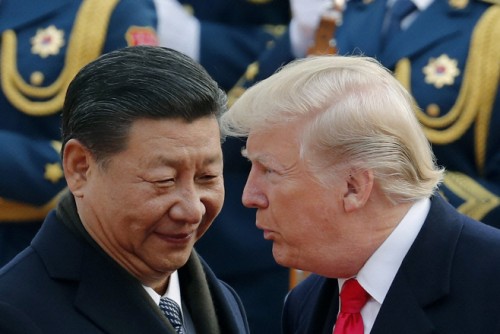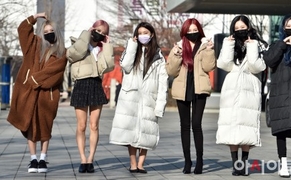 |
| Donald Trump, then U.S. president (right), speaks with Chinese President Xi Jinping during a welcome ceremony at the Great Hall of the People in Beijing, China, on November 9, 2017. / Source: AP-Yonhap News |
On April 7, U.S. President Donald Trump warned that he would impose an additional 50% tariff on Chinese goods, while signaling that he is ready to begin immediate tariff negotiations with other countries.
His approach is firm toward China, which responded to U.S. tariffs by imposing a 34% retaliatory tariff on American goods, while extending a conciliatory gesture toward other countries that are actively engaging with Washington—whether by dispatching delegations to the U.S. capital, contacting Trump directly, or proposing tariff reductions on American products.
In a post on his social media platform Truth Social, Trump warned that if China does not withdraw its 34% tariffs by April 8, the U.S. would impose a 50% additional tariff on Chinese goods starting April 9.
Trump added that if China refuses to comply, “all dialogue requested by China with the U.S. will be canceled,” but “negotiations with other countries that requested talks with the U.S. will begin immediately.”
He reiterated this stance during a meeting with Israeli Prime Minister Benjamin Netanyahu in the Oval Office at the White House on the same day.
“This is the only chance to reset America’s trade negotiating table,” Trump said. “Countries that have truly taken advantage of us are now begging to negotiate because they’ve been hit hard.”
“Many countries are coming to negotiate with us,” he continued. “These will be fair agreements, and in many cases, they will pay significant tariffs. We’re making tremendous progress with many nations. We will once again become an economically strong country.”
Trump also stressed, “China has already retaliated with a 34% tariff, which is absurd compared to our tariffs. If they don’t withdraw it by midnight on the 8th, we will add another 50% on top.”
As for concerns that other nations may grow closer to China due to U.S. tariffs, Trump dismissed them, saying, “I’m not worried. They want to rely on America.”
When asked whether the European Union’s offer to eliminate tariffs on U.S. industrial goods was sufficient, Trump replied, “No, it’s not.”
He added, “Many countries want to eliminate tariffs immediately,” but emphasized that “tariffs are a big part, but there’s another major part—non-tariff barriers,” arguing that “they make it very difficult to sell anything.”
With Trump set to begin immediate negotiations with countries other than China, South Korea is expected to open trade talks during Trade Minister Jeong In-kyo’s visit to Washington, D.C., scheduled for April 8–9.
Since taking office, Trump has imposed a 25% item-specific tariff on steel, aluminum, automobiles, and parts. Starting April 5, he implemented a 10% basic (universal) tariff on all U.S. trading partners. From April 9, the U.S. will apply reciprocal tariffs exceeding the basic 10% rate to more than 60 countries and regions, including South Korea (25%), China (34%), the EU (20%), and Japan (24%).
In China’s case, the total tariff rate on U.S. goods could exceed 54% when the newly announced 34% retaliatory tariff is added to the existing 20% tariff on fentanyl precursor imports—commonly referred to as components of the “zombie drug.”
Most Read
-
1
-
2
-
3
-
4
-
5
-
6
-
7





















